Sep-18-21
 | | KEG: Quite an exciting struggle, despite all the missed oppoies. Janowski was already ahead of the field, and with this victory pulled further ahead of the other competitors. It appeared he would match his triumph at Monte Carlo 1901 by winning again in 1902. It was only later in the tournament that he was overtaken and surpassed by Maroczy and Pillsbury. In this long struggle, Albin went all in on a King-side pawn storm and attack. The concept was not entirely sound, but got some good chances before he faltered. When Janowski let him off the hook, Albin got an endgame in which he should at least have drawn. But he blundered on his 47th turn, and Janowski won a piece for two pawns. He nearly flubbed the ending on several occasions, but after Albin's mistake on move 67 coasted home. This is one of those games in which the mistakes makes the contest more rather than less interesting and instructive to play over. 1. e4 e5
2. Nf3 Nc6
3. Bb5 a6
4. Ba4 Nf5
5. 0-0 Nxe4
6. d4 b5
7. Bb3 d5
8. dxe5 Be6
The standard position in the Open Ruy Lopez
9. c3
One can debate the respective merits of this and 9. Nbd2 will the cows come home. Both have their points, and both lines can transpose to the same or similar positions. 9... Bc5
Here, too, the choice (between text and 9...Be7) is a matter of dispute. I much prefer the text. 10. Nbd2

click for larger viewThus far, nothing notable or unusual had occurred. But now things got wild. 10... NxN?!
10...0-0 is usual and--from any sort of theoretical perspective--is best. But Albin had something cooked up for Janowski. 11. QxN
11. BxN is also good. But as Janowski's next move revealed he had a very definite reason for choosing the text. 
click for larger view11... h6?!
"An original experiment. Black plans a pawn storm against the enemy King." (Tournament Book) 11...0-0 or 11...Qd7 would be sounder, but Albin adhered to his plan. Against a fierce attacker such as Janowski, assuming the role of attacker was not a bad strategy. 12. Qf4

click for larger view"Pillsbury believed the text to be admirable, but 12. a4 to be even stronger." (Tournament Book) 12... g5
Having said "A," Albin decided he might as well say "B" as well. 13. Qg3?!
Janowski was also itching for fisticuffs, else he would have played the sound (and almost certainly better_13. Qd2. The position was now:

click for larger view |
|
Sep-18-21
 | | KEG: Post II
13... g4
Stronger and more consistent with Albin's plan was 13...f5. 14. Ne1 h5
The march continues:

click for larger view15. Nd3 h4!

click for larger viewGetting dicey for both sides!
16. Qf4 Be7
16...Bb6 or 16...Bf8 were perhaps more accurate. 17. a4

click for larger view17... Na5
Surprising that Albin didn't continued with the indicated 17...h3. Not quite sure how sound that all would be, but it seems a bit late to be backing down now. 18. Bd1 Rg8

click for larger view19. axb5
It was perhaps premature to lessen the tension. While Janowski's move was hardly bad, 19. Re1 or 19. Qh6 seem more in keeping with Janowski's normal fighting spirit. 19... axb5
20. Qh6
20. Be3 was surely better. But Janowski's move turned out just fine in light of Albin's response, the position now being (after 20. Qh6): 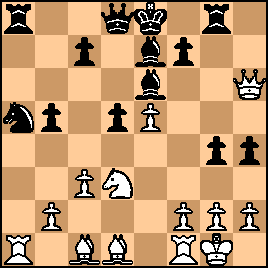
click for larger view20... Nb7?
Very weak. Perhaps time pressure played a role as the players neared the move-30 time control. The best way to dampen White's attacking chances was with 20...Kd7. 21. RxR QxR
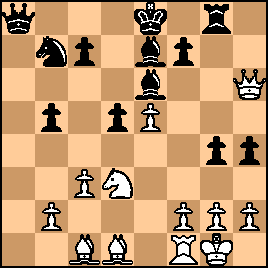
click for larger viewAs is obvious, the exchange of Rooks improved White's chances remarkably. White's position isn't won yet, but he had all the chances at this poing. |
|
Sep-19-21
 | | KEG: Post III
22. Nf4 Kd7
Albin should have made this essential defensive move before. At this stage, is represented his only hope of survival.. 
click for larger view23. NxB
Although Janowski still had much the better chances after this exchange, even stronger were 23. b4 or, perhaps more simply, bringing his White-square Bishop into active play with 23. Be2. But this trade of minor pieces was true to Janowski's philosophy of chess: Bishops were almost always better than Knights. 23... fxN
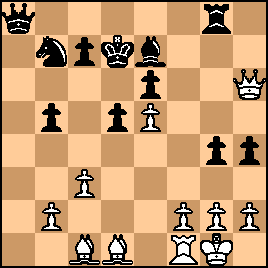
click for larger view24. Qh5
Pursuing a ghost. Better were 24. b4 or 24. Be2 24... g3!
Seizing his chance to get counterplay.
25. fxg3

click for larger viewPost III
22. Nf4 Kd7
Albin should have made this essential defensive move before. At this stage, is represented his only hope of survival.. 
click for larger view23. NxB
Although Janowski still had much the better chances after this exchange, even stronger were 23. b4 or, perhaps more simply, bringing his White-square Bishop into active play with 23. Be2. But this trade of minor pieces was true to Janowski's philosophy of chess: Bishops were almost always better than Knights. 23... fxN

click for larger view24. Qh5
Pursuing a ghost. Better were 24. b4 or 24. Be2 24... g3!
Seizing his chance to get counterplay.
25. fxg3

click for larger view25... Qa7+?
Correct here was the simple 25...hxg3 (26. hxg3 Rh8!) This intermediate appears to be at worst harmless, but fact it was a losing blunder, since it gave Janowski time to get his King to h1. It is remarkable that this kind of seemingly at worst innocuous move could be so costly. But so it proved. Off the top of my head, I cannot recall another gave where this kind of check (preceding as it does hxg3 on Black's very next move) was so problematic. But this is part of the nearly infinite variety of chess. 26. Kh1 hxg3?
Having erred on his 25th turn, Albin now had to play 26...Qa1 or 26...Qa8 After 26...hxg3?, the game was (theoretically at least) lost for Black: 
click for larger viewWhite to play and win. |
|
Sep-19-21
 | | KEG: Post IV
27. Bg4?
"!"--(Tournament Book)
The Tournament Book notwithstanding, this move was a mistake. In light of Albin's unfortunate 25th move, the h-file was closed. This afforded Janowski a chance to pull off a neat combination instead of letting Albin back in the game. The winning move here is 27. Qh7! Black has no saving retort. If, for example, 27...Qb8 White wins with 28. Rf7 since 28...Qe8 loses to 29. RxB+ and 28...Re8 loses to 29. Bg5. Superficially, Black can survive after 27. Qh7 with 27...Qa1. But White then has a cute win with 28. Be2 and Black is sunk (e.g., 28...Rf8 29. QxB+ KxQ 30. Bg5+ Kd7 31. RxQ leaving White a piece up in an easily won endgame. But Janowki's 27. Bg4 left:
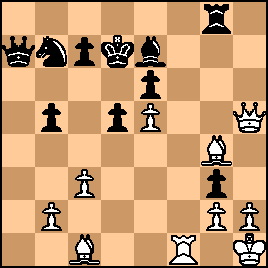
click for larger view27... Nd8!
All of a sudden, Black can hold.
28. hxg3 Qa4
Well played again by Albin.
29. Bh3
The best shot, but White's win was gone.
29... Rxg3
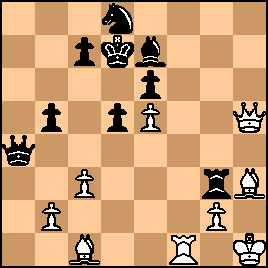
click for larger view30. Bf4
Janowski had to play 30. Kh2 to retain any semblance of an advantage. After the text, he had to fight to avoid actually losing what had only moves ago had been a won game. 30... Qc4

click for larger viewAs is obvious, Janowki now had threats he had to worry about. Time pressure was over, move 30 having been reached, and the game remained very complicated. It is hard to asses who is better at this point. I would expect the better played to win here from either side. 31. Rf2 Rg7
32. Kh2 Bc5
33. Rf3

click for larger view33... Qe4
"The threat of Qe1is easily parried. After 33...Qe2 [to prevent Rf1], the following interesting variation could have occurred: 34. Be3 BxB 35. Rf7+ NxR! 36. QxQ Bf4+ 37. Kg1 c6! followed by Bxe5. With Rook and Knight for Queen, Black is probably OK at the end of this variation. White would have had slightly better prospects with 37. Kh1 Bxe5 38. Qxb5+, but Black can likely still hold. 34. Rf1

click for larger viewAny advantage now lies with Black.
The climax of the game, however, was yet to come. |
|
Sep-19-21
 | | KEG: Part V
34... c6
34...Rf7 is also fine for Black.
35. b4 Bb6
36. Bg3 Rh7
37. Qf3 Qc4

click for larger view"After excellent play, Blaxk has consolidated his position and now threatens to gain the advantage by Rf7." (Tournament Book). 38. Qf8
"There is nothing better." (Tournament Book)
Probably true, but 38. Bf4 is also OK.
38... Qxc3
38...Qg4 looks like a better way to try to make something out of Black's tiny advantage. 39. Qd6+

click for larger view39... Kc8
Not 39...Ke8?? 40. Rf8 mate.
40. Rf8 Rh6
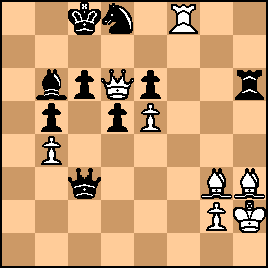
click for larger view41. Rg8?
This should have led to trouble. Janowski would have been fine with 41. Bh4! RxB 42. Qxe6+ Kb7 43. Qe7+ Bc7 44. QxR Qxe5+ 45. g3 Ne6 46. BxN QxB 47. Rf2 and Black, with Bishop and Pawn for Rook, is well situated to be able to hold the game. 41... Qc1
42. Bf2
"!"--(Tournament Book)
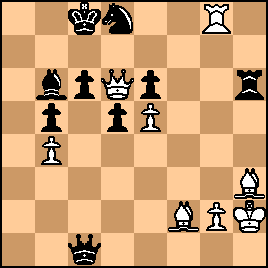
click for larger view42... Bc7?
42...Qf4+ was much stronger and would have afforded Albin at least practical chances of winning. Though hardly fatal, the text was Albin's first step towards ruining his game and giving Janowski the chance to spring a winning combination. 43. Qe7
"!"--(Tournament Book)
43... Bxe5+
This kisses off any chance Albin may have had to retain any semblance of an advantage. 43...Qb2 or 43...Qf4+ would have made Janowski continue to work hard to survive. 44. Bg3
He could as well played 44. g3.
544... BxB+
45. KxB Qe3+
46. Kh2

click for larger view |
|
Sep-20-21
 | | KEG: Post VI
46... Qb6
"??"--(Tournament Book)
"An unlucky idea. By 46...Qe5+ Black could force a draw by perpetual check or after 47. Kh1 play for a win by 47...Qc7 48. RxN+ QxR 49. Bxe6+ RxB 50. QxR Qd7). Talk about poor analysis!
For starters, and as I will discuss below, Black is still fine after the text. And Black--in addition to the text and the suggested 46...Qe5+, could have had an easy draw by perpetual text with 46...RxB+ But even with regard to 46...Qe5 check, the Tournament Book's analysis is dreadful. For one thing, and as the Tournament Book does not seem to question, the game is a draw if White plays 47. Kg1 (instead of 47. Kh1??) Even if we confine our discussion to the situation after 46...Qe5+ 47. Kh1?, the Tournament Book's anaysis is absurd. 47...Qc7! is the winning move, but White can put up at least some semblance of a fight with 48. Qg5 or 48. Qc5 or perhaps even 48. Qf8. But the Tournament Book only considers 49. RxN+?? QxR. It then suggests 49. Bxe6+ which happens to be an illegal move, since the Bishop is pinned since--in this line--the White King is on h1. In any case, let's now consider the move denounced by the Tournament Book, Albin's actual 46...Qb6. The position after that move was:

click for larger view47. Rg7
Forced.
This left:
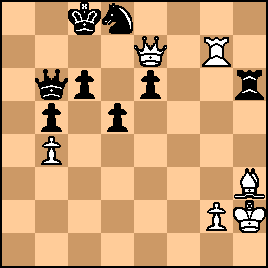
click for larger view47... Qb7?
This was the losing move. Albin would have been fine with 47...Rh5, 47...Rh8, or 47...d4. After the text, Janowski had two ways to win, the position now being: 
click for larger view48. QxN+
"!"--(Tournament Book)
White also wins with 48. Qg5!, which permits a different but also pretty winning combination: e.g., 48...Nf7 49. Qf4 Qc7 50. RxN! QxQ+ 51. RxQ leaving White up a piece for two pawns plus a passed g-pawn that allows a fairly easy win. But let's return to the actual game:
48... KxQ
49. RxB
[bad FEN: 3k5/1R6/2p1p2r/1p1p4/1P6/7B/6PK/8]
This should have been an even easier win for White than in the above 48. Qg5 line. But as will be seen Janowski made heavy weather of the ending and almost blew the win. 49... d4
If 49...e5 White wins after 50. g4 Ke8 51. Kg3 d4 52. g5 Rg6 53. Rb8+ Kf7 54. Kg4. 50. Kg3
50. Rf7 is easier, but the text also wins.
50... Rf6
50...e5 would make the finish a bit more difficult for White. 51. Ra7
Keeping the Black King restricted to the back rank is one way to win. 51. Bg4 immediately was another winning line. 51... e5
52. Bg4 Rd6

click for larger view |
|
Sep-20-21
 | | KEG: Post VII
53. Kf3
To cinch the win, White need only stop the two Black passed pawns after which he can advance his own passed pawn. 53... d3
54. Ke3 d2
55. Bd1

click for larger viewThe game now seems clearly won for White. But there were some serious ups and downs with the always unpredictable at the controls. 55... Rd4
Eyeing the White pawn at b4.
56. g4

click for larger view56... Rxb4?
56...Ke8 was better. The text should have made Janowski's task easy, the position now being: 
click for larger view57. Kxd2?
This made life more difficult for Janowski. A more solid road to wrapping up the game was 57. g5 Ke8 58. Rc7 Rc4 59. g6 Kf8 60. Kxd2 Rd4+ 61. Kc1 57... Rd4+
58. Ke1 Rd6
59. Be2
59. Rh7 or 59. Bc2 were better.
59... b4
Deciding that attack (i.e., pushing his pawns) was the best form of defense. On a purely theoretical perspective, 59...Kc8 was best. 60. Rb7 c5

click for larger view61. Rb5
Supporting the advance of his g-pawn with 61. Kf2 was stronger, but the text most certainly did not blow the wind. 61... Rc6
62. Kd2 Ke7
63. Kd3
63. Ke3 was more accurate.
63... Kf6

click for larger viewThe game seems still well in hand for White. But beginning with the above-diagrammed position Janowski misplayed badly and--had Albin seized his opportunities--would have been compelled to settle for a draw. |
|
Sep-20-21
 | | KEG: Post VIII
64. Bf3?
Now the win is problematic. Even a beginner might be expected to play the obvious 64. Ke4. 64... Rc7

click for larger view65. Be4?
Blocking his own King and continuing to pursue a misguided plan. With 65. Ke2 or 65. Kd2, White should still win. After the text, Janowski's pieces hampered each other, and the win seemed to be gone. 65... Kg5
66. Bf5

click for larger viewNow, Albin had a likely draw with 66...c4+ or--perhaps better still--66...Kf4. Instead he dawdled with: 66... Rc6??

click for larger viewJanowski now had a fairly simple win with 67. Kc4 or 67. Ke4. But, incredibly blew the win again, this time with: 67. Rb8?

click for larger viewIt is hard to see how Janowski could have won had Albin played the seemingly obvious 67...c4+ But... 67... Kf6?
Incredible. After this error, Janowski had no further problems scoring up the win: 68. Ke4

click for larger viewThe game was gone for Black anyway, but Albin considerably eased White's task with: 68... Rd6?
68...b3 or 68...c4 would almost certainly not have saved the game, but the text was entirely hopeless. 69. Rf8+ Ke7?
Albin may have abandoned hope. If not, he presumably would have tried 69...Kg7. The position was now:

click for larger viewThe end was near, but there were a few points of interest in the remaining moves. |
|
Sep-20-21
 | | KEG: Post IX
70. Rc8
It is hard to understand why Janowski didn't play the immediately crushing 70. Rh8 or simply play 70. Kxe5. The text also wins, but the text only prolonged the game. It did not alter the inevitable outcome. 70... Kf6
71. Rxc5

click for larger viewAlbin might well have called it a day now, but he played on. 71... Rd4+
72. Kf3 Rf4+
72...Rd1 or 72...Rd6 would have offered somewhat stiffer resistance. The text only drove the White King to a better square. 73. Kg3
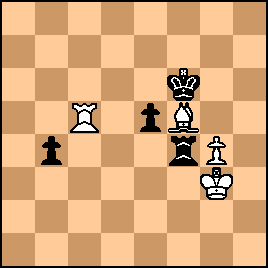
click for larger view73... Rd4
Equivalent to resignation. But 73...b3 or 73...Rf1 would not have been much improvement. 74. Rc6+
Fastest.
74... Kf7
75. g5

click for larger view75... Rf4
76. Rc7+
76. g6+ was faster.
76... Kf8
77. Be6
Leaving Black no hope.

click for larger view77... Rf1
78. Kg2
1-0 |
|
|
|
|





